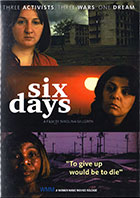
Six Days: Three Activists, Three Wars, One Dream 2013
Distributed by Women Make Movies, 115 W. 29th Street, Suite 1200,New York, NY, 10001; 212-925-0606
Produced by Johan Sandström
Directed by Nikolina Gillgren
DVD, color, 56 min., Abkhaz, Sorani Kurdish, and Mengrelian with English subtitles
High School - General Adult
Activism, Domestic Violence, War, Women’s Rights
Date Entered: 09/15/2015
Reviewed by Wendy Highby, University of Northern ColoradoThe three women’s rights advocates in Six Days: Three Activists, Three Wars, One Dream share a common ideal: they are fiercely determined to improve the lives of women. Each of them has suffered and witnessed the horrific violence, loss, and upheaval associated with armed conflict. And in peacetime the suffering continues; women bear the brunt of the victimization (in the form of domestic violence) that continues in war’s aftermath. Unfortunately, this tragedy is not confined to one part of the world; the film shows its manifestations in Africa, the Middle East, and Eurasia.
Nelly S. Cooper is a survivor of Liberia’s two civil wars. In Monrovia, she runs a sewing cooperative and shelter (The West Point Women for Health and Development Organization) and teaches women to read. Lanja Abdullah, a journalist in Erbil, Iraq’s Kurdistan region, works with police to rescue domestic violence victims. She is the head of Warvin, a women’s rights organization that advocates for women’s full participation in conflict resolution and peacebuilding. Maia Kvaratskhelia of Abkhazia, in the Republic of Georgia, is the director of a women’s health group, Avangard. She brings medical care and education to children and women in remote Caucasus villages in the Gali District. All three activists bravely confront misogyny at its worst. Maria seeks to stop bride kidnappings, Lanja works to prevent honor killings, and Nelly constructively transforms her post-traumatic stress into the positive resolve to help women flourish economically and help themselves.
The vérité style of the film is the perfect perspective for this topic. The women are shown going about their daily routines; their activism is simply an integral part of the quotidian. While commuting with her husband, Lanja discusses a threatening phone call she received from a victim’s abuser. After Maia engages in a serious conversation with teens in a sex education class, one of the young men responds by dancing. It is a profoundly beautiful and transformative moment in the film, as they have just been discussing the ugliness of forced marriage by kidnapping. In the evening, Nelly encourages the women in her English class, cheering them on like a coach. By day, she doggedly supervises construction workers who build her co-op’s storefront. This day-in-the-life style of filmmaking makes the activism, while very heroic, also quite relatable and accessible. Altruism is the accretion of single acts of kindness and bravery, not the work of super-heroes. These women have not forgotten their trauma, but it has been tamed and harnessed. It carries each of them like a faithful horse through their daily activities, serving as a source of indomitable, indefatigable resolve. The profound example of this trio of activists will inspire emulation in students and volunteers of all ages.
The film is well-edited, moving deftly as it toggles among the lives of the three protagonists. It is an ideal length for classroom screenings and is appropriate for high school age and up. This documentary would support curriculum in gender studies, peace studies, women’s studies, international studies, political science, sociology, social work, and service learning. Students will be engaged by the personal focus of the story; it will heighten their awareness of misogyny and the importance of women’s rights, enhancing their understanding of the social dynamics of gender-based violence in post-conflict societies. It also has the potential to pique their interest in learning more about international social movements for human rights.